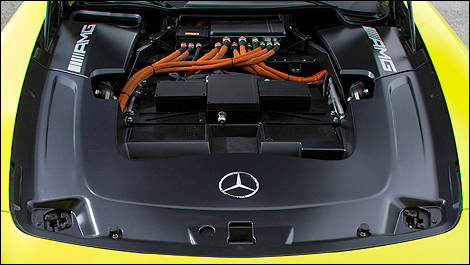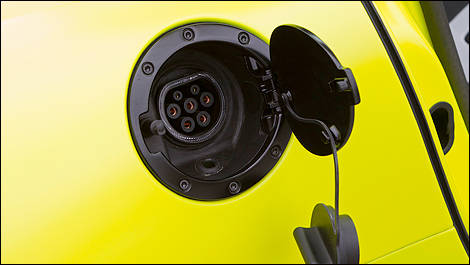Acceleration from zero to 100 km/h in 4 seconds
When it comes to dynamics, the electrically-powered SLS AMG makes a statement: the gullwing model accelerates from zero to 100 km/h in 4 seconds - which almost puts it on the same high level as the SLS AMG with 6.3-litre V8 engine developing 420 kW (571 hp), which can accelerate to 100 km/h in 3.8 seconds.
Further exciting touches are provided courtesy of the agile accelerator response and the straight-line performance: unlike the combustion engine, torque build-up with an electric motor is instantaneous - maximum torque is available virtually from a standstill. The spontaneous torque build-up and confident power delivery - which does not suffer from any interruption of tractive power - are combined with engine running characteristics which are totally free of vibration. Four motors, four wheels: the intelligent and permanent all-wheel drive of the electric SLS guarantees driving dynamics at the highest level, while at the same time providing the best possible active safety. Perfect traction is therefore ensured for all four driven wheels, whatever the weather conditions.
This very special gullwing is therefore able to "electrify" the driver with a completely unique, effortlessly superior and emotional super sports car driving sensation - and this is just at the prototype stage. In brief: the SLS AMG E-CELL is a true AMG too.
High-voltage lithium-ion battery provides 400 v and 40 Ah
The SLS AMG E-CELL drive incorporates a liquid-cooled high-voltage lithium-ion battery featuring a modular design with an energy content of 48 kWh and a capacity of 40 Ah. The maximum electric load potential of the battery, which consists of 324 lithium-ion polymer cells, is 480 kW, which is an absolute best value in the automotive sector. Another technical feature of this considerable performance is the intelligent parallel circuit of the individual battery modules - this also helps to maximise the safety, reliability and service life of the battery. The 400-volt battery is charged by means of targeted recuperation during braking whilst the car is being driven.
High-performance electronic control as well as effective cooling of all components
A high-performance electronic control system converts the direct current from the high-voltage battery into three-phase alternating current which is required for the synchronous motors and regulates the energy flow for all operating conditions. Two low-temperature cooling circuits ensure that the four electric motors and the power electronics are maintained at an even operating temperature.
When it comes to dynamics, the electrically-powered SLS AMG makes a statement: the gullwing model accelerates from zero to 100 km/h in 4 seconds - which almost puts it on the same high level as the SLS AMG with 6.3-litre V8 engine developing 420 kW (571 hp), which can accelerate to 100 km/h in 3.8 seconds.
 |
| Photo: Mercedes-Benz |
Further exciting touches are provided courtesy of the agile accelerator response and the straight-line performance: unlike the combustion engine, torque build-up with an electric motor is instantaneous - maximum torque is available virtually from a standstill. The spontaneous torque build-up and confident power delivery - which does not suffer from any interruption of tractive power - are combined with engine running characteristics which are totally free of vibration. Four motors, four wheels: the intelligent and permanent all-wheel drive of the electric SLS guarantees driving dynamics at the highest level, while at the same time providing the best possible active safety. Perfect traction is therefore ensured for all four driven wheels, whatever the weather conditions.
This very special gullwing is therefore able to "electrify" the driver with a completely unique, effortlessly superior and emotional super sports car driving sensation - and this is just at the prototype stage. In brief: the SLS AMG E-CELL is a true AMG too.
High-voltage lithium-ion battery provides 400 v and 40 Ah
The SLS AMG E-CELL drive incorporates a liquid-cooled high-voltage lithium-ion battery featuring a modular design with an energy content of 48 kWh and a capacity of 40 Ah. The maximum electric load potential of the battery, which consists of 324 lithium-ion polymer cells, is 480 kW, which is an absolute best value in the automotive sector. Another technical feature of this considerable performance is the intelligent parallel circuit of the individual battery modules - this also helps to maximise the safety, reliability and service life of the battery. The 400-volt battery is charged by means of targeted recuperation during braking whilst the car is being driven.
High-performance electronic control as well as effective cooling of all components
A high-performance electronic control system converts the direct current from the high-voltage battery into three-phase alternating current which is required for the synchronous motors and regulates the energy flow for all operating conditions. Two low-temperature cooling circuits ensure that the four electric motors and the power electronics are maintained at an even operating temperature.
 |
| Photo: Mercedes-Benz |


